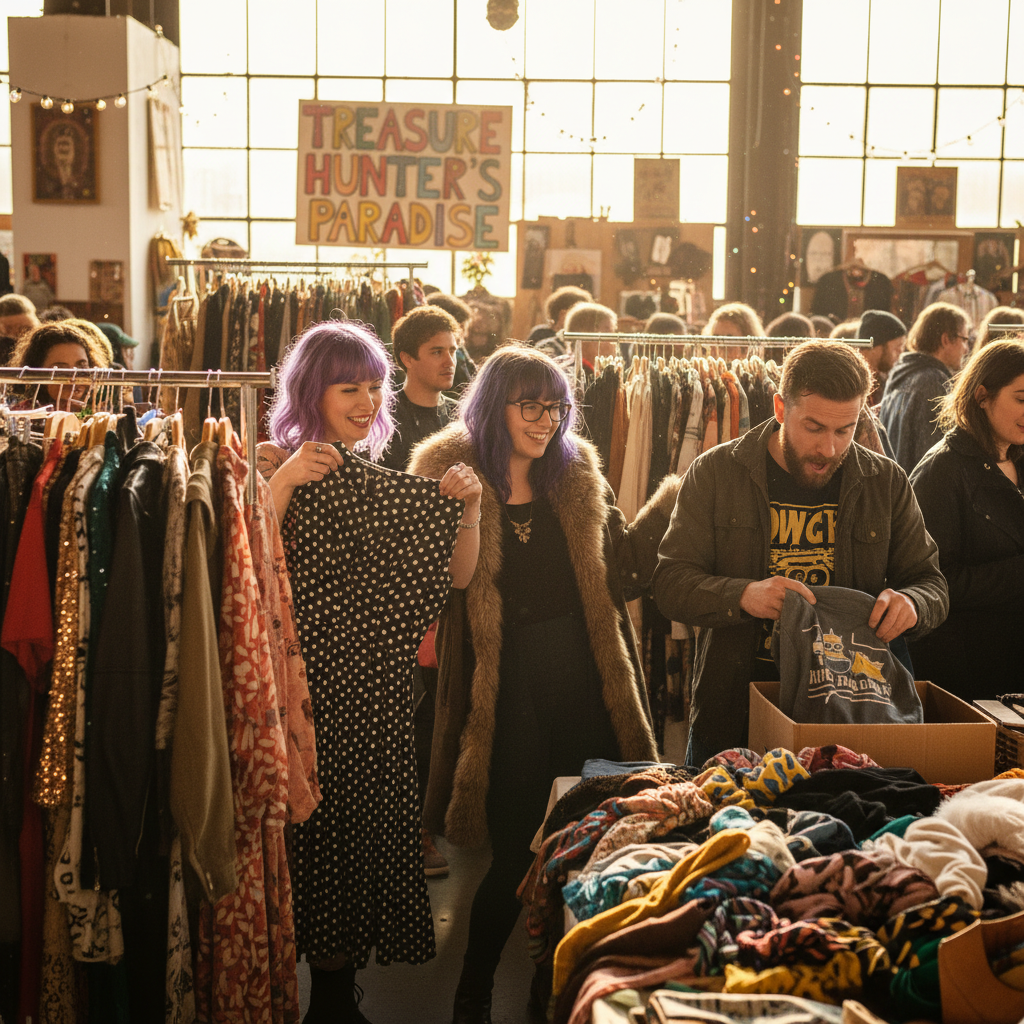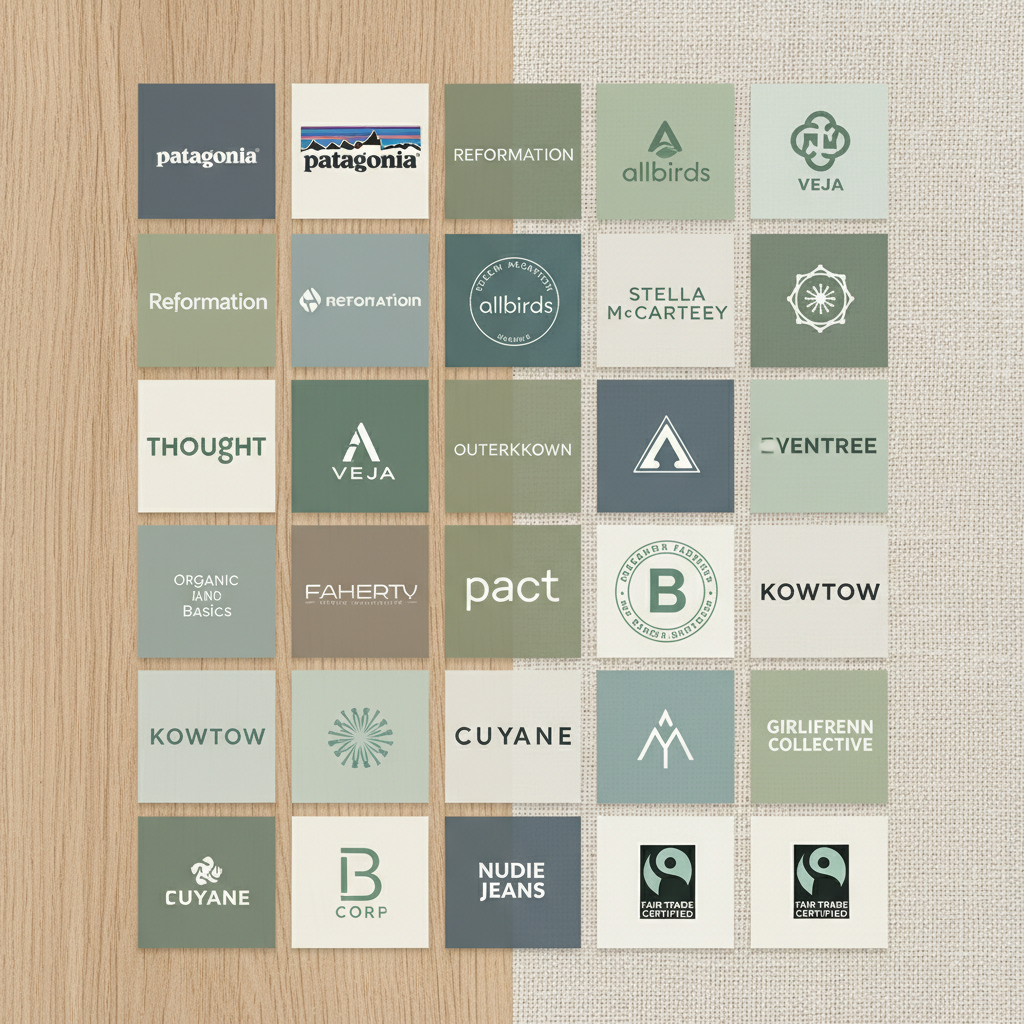
Sustainable Style: Your Guide to Eco-Friendly Fashion Choices
Sustainable Style: Your Guide to Eco-Friendly Fashion Choices

Introduction
In a world captivated by fleeting trends and instant gratification, the allure of fast fashion is undeniable. From the latest runway looks to affordable everyday wear, the industry constantly churns out new collections, tempting consumers with an endless stream of sartorial delights. Yet, beneath the glittering surface lies a sobering truth: the fashion environmental impact is immense, and its human cost is often overlooked. Our collective fashion footprint has reached unsustainable levels, making a shift towards more sustainable fashion choices not just a trend, but a necessity.
This comprehensive guide is your essential companion on the journey to embracing sustainable style. We’ll delve into the true meaning of eco-friendly clothing, explore the innovative world of ethical fashion brands, and equip you with the eco fashion tips needed to cultivate a truly sustainable wardrobe. From understanding the slow fashion movement to navigating the intricacies of circular fashion, you’ll learn how to make informed decisions that benefit both your style and the planet. Get ready to transform your approach to fashion through conscious consumerism fashion and discover a path to dressing with purpose, integrity, and genuine style.
The True Cost of Convenience: Understanding Fashion’s Environmental and Social Impact
Before we dive into solutions, it’s crucial to grasp the scale of the challenge. The fashion industry, particularly its fast-fashion segment, is a colossal global machine with profound consequences for our planet and its people.
Fast Fashion’s Footprint: A Global Challenge
The lifecycle of a typical garment, from its raw materials to its eventual disposal, leaves a trail of environmental degradation. This is where the concept of fashion environmental impact truly hits home.
- Resource Depletion: Cotton, a primary fiber, is incredibly water-intensive, often grown in regions facing severe water scarcity. Synthetic fibers like polyester are derived from fossil fuels, contributing to oil dependence and greenhouse gas emissions. The energy required for manufacturing, transportation, and retail further exacerbates the problem.
- Chemical Pollution: The dyeing and finishing processes in textile production are notorious for using hazardous chemicals, which often pollute waterways in developing countries, harming ecosystems and local communities. This directly impacts the sustainability of sustainable textiles if not managed properly.
- Waste Crisis: The rapid turnover of fast fashion leads to an astronomical amount of textile waste. Millions of tons of clothing end up in landfills annually, where synthetic materials can take hundreds of years to decompose, releasing microplastics and greenhouse gases. Even natural fibers contribute to landfill bulk if not properly composted. This vast fashion footprint is a testament to a linear “take-make-dispose” model that is no longer viable.
Beyond the Environment: The Human Cost of Unethical Production
The pursuit of cheap, quickly produced clothing often comes at a devastating human cost. This highlights the urgent need for ethical sourcing fashion and a commitment to fair trade clothing.
- Labor Exploitation: In many garment-producing nations, workers, predominantly women, are subjected to long hours, abysmal wages (often below minimum living standards), and unsafe working conditions. Tragedies like the Rana Plaza collapse in Bangladesh serve as stark reminders of the human toll of unchecked production demands.
- Health and Safety Risks: Exposure to toxic dyes and chemicals, poor ventilation, and inadequate safety measures are common in many factories, leading to chronic health issues for workers.
- Lack of Transparency: The complex global supply chains make it difficult to trace a garment’s journey, allowing brands to obscure unethical practices. This lack of transparency in fashion is a significant barrier to accountability.
Fortunately, a growing number of sustainable fashion initiatives are working tirelessly to challenge these norms, advocating for better wages, safer conditions, and greater transparency across the industry.

Decoding Sustainable Style: What Eco-Friendly Really Means
Given the complexities, understanding what truly constitutes sustainable style and eco-friendly clothing can feel overwhelming. It’s more than just a buzzword; it’s a holistic approach that considers the entire lifecycle of a garment.
More Than Just ‘Green’: Defining Sustainable and Ethical Fashion
The terms “sustainable” and “ethical” are often used interchangeably, but they have distinct nuances that are important for conscious consumerism fashion.
- Sustainable Fashion: Primarily focuses on the environmental impact of clothing production and consumption. It aims to minimize ecological harm, conserve resources, and prevent pollution throughout the supply chain. This includes everything from the choice of sustainable textiles to waste reduction strategies.
- Ethical Fashion: Concentrates on the social impact, ensuring fair labor practices, safe working conditions, and respect for human rights across the supply chain. Fair trade clothing is a key component of ethical fashion.
When a brand genuinely embodies both, it becomes an ethical fashion brand, committed to positive environmental and social practices. This contrasts sharply with “greenwashing,” where brands make misleading claims about their environmental efforts without substantive action.
One of the most powerful responses to fast fashion’s relentless pace is the slow fashion movement. This philosophy encourages consumers to buy fewer, higher-quality items, produced with respect for people, planet, and animals. It’s about valuing craftsmanship, durability, and timeless design over fleeting trends.
The Principles of Circular Fashion
The traditional linear fashion model, where resources are extracted, products are made, used, and then thrown away, is fundamentally unsustainable. Circular fashion offers a revolutionary alternative.
Instead of a linear path, circular fashion aims to keep resources in use for as long as possible, extracting maximum value from them while in use, then recovering and regenerating products and materials at the end of each service life. This involves:
- Design for Longevity: Creating durable, high-quality garments that last longer and can be repaired. This is a core principle of longevity in fashion.
- Waste Reduction: Minimizing waste at every stage, from design to production.
- Material Cycling: Using materials that can be safely returned to the biosphere (biodegradable) or continuously reused in technical cycles (recycled clothing).
- New Business Models: Encouraging rental, repair, resale, and redesign services to extend garment life.
By embracing circular principles, we can drastically reduce the fashion environmental impact and move towards a more regenerative system.
Key Terms to Know: From Vegan to Zero Waste
As you navigate the world of green fashion trends, you’ll encounter various terms that define specific aspects of sustainable practice.
- Vegan Fashion: This refers to clothing and accessories made without any animal products whatsoever. This includes avoiding leather, wool, silk, fur, and even some glues or dyes derived from animals. Vegan fashion prioritizes animal welfare alongside environmental considerations.
- Zero Waste Fashion: Designers and brands committed to zero waste fashion employ patterns and cutting techniques that utilize 100% of the fabric, leaving no scraps behind. This drastically reduces textile waste during the production phase.
- Eco Chic Style: This term describes a fashion aesthetic that is both environmentally conscious and stylish. It proves that eco-friendly clothing doesn’t have to sacrifice aesthetics for ethics, often featuring minimalist designs, natural textures, and timeless pieces.
Understanding these terms empowers you to make more informed sustainable fashion choices.
The Building Blocks of a Green Wardrobe: Sustainable Materials and Practices
At the heart of eco-friendly clothing are the materials and the methods used to create them. A truly sustainable wardrobe is built on a foundation of thoughtfully sourced and produced textiles.
Earth-Friendly Fabrics: A Guide to Sustainable Textiles
The choice of fabric profoundly influences a garment’s fashion environmental impact. Here’s a look at some leading sustainable textiles:
- Organic Cotton Fashion: Grown without synthetic pesticides, herbicides, or genetically modified organisms (GMOs), organic cotton fashion significantly reduces water pollution and protects soil health. Look for certifications like GOTS (Global Organic Textile Standard) to ensure authenticity.
- Recycled Materials:
- Recycled Polyester (rPET): Made from recycled plastic bottles, rPET diverts waste from landfills and reduces the need for virgin fossil fuels. It’s common in activewear and outerwear.
- Recycled Cotton: Utilizes textile waste from manufacturing or post-consumer garments, reducing the demand for new cotton and conserving resources.
- Recycled Wool: Similar to cotton, recycled wool reuses existing fibers, minimizing waste and the intensive resources required for new wool production.
- Linen and Hemp: These natural fibers are highly sustainable. They require minimal water and pesticides, are naturally durable, and biodegradable. Hemp is particularly resilient and grows quickly without depleting soil nutrients.
- Tencel™ and Modal™ (Lyocell and Modal): These are cellulosic fibers made from sustainably harvested wood pulp (eucalyptus for Tencel, beechwood for Modal) using a closed-loop system that recycles water and solvents. They are known for their softness, breathability, and drape.
- Innovative Materials: The frontier of sustainable fashion materials is constantly expanding, with innovations like mushroom leather, pineapple leaf fibers (Piñatex), and algae-based dyes offering promising alternatives to traditional materials.
Beyond Materials: Ethical Production and Supply Chains
While material choice is critical, it’s only one piece of the puzzle. The processes and people involved in making the fabric into a finished garment are equally important for genuine sustainable style.
- Fair Trade Clothing and Living Wages: A hallmark of ethical fashion brands is their commitment to fair trade clothing principles. This ensures that workers receive fair wages, work in safe conditions, and have the right to organize. It’s about empowering communities, not exploiting them.
- Local Production: Supporting brands that manufacture locally can reduce transportation emissions and often provides better oversight of labor conditions. However, “local” can vary by region, and global supply chains can also be ethical if managed with transparency.
- Resource-Efficient Manufacturing: Responsible factories implement water-saving technologies, use renewable energy, and treat wastewater before discharge. They also focus on minimizing textile waste through efficient pattern cutting and recycling programs, aligning with circular fashion principles.
- Transparency and Certifications: Brands that offer full transparency in fashion by disclosing their supply chain, from fiber to finished product, empower consumers to make informed choices. Certifications like Fair Trade, GOTS, B Corp, and Bluesign provide independent verification of environmental and social standards, making it easier to identify truly ethical fashion brands. Many sustainable fashion initiatives also publish detailed fashion sustainability report documents to showcase their progress.
Curating Your Conscious Closet: Practical Eco Fashion Tips
Building a sustainable wardrobe doesn’t require a complete overhaul overnight. It’s a journey of mindful choices, practical strategies, and a shift in perspective. Here are some key eco fashion tips to guide you.
Embrace the “3 Rs”: Reduce, Reuse, Recycle
The classic environmental mantra applies perfectly to sustainable fashion choices.
- Reduce: The most impactful step is to buy less. Before making a purchase, ask yourself: Do I really need this? Will I wear it at least 30 times? Invest in high-quality, versatile pieces that you love and that will last, aligning with longevity in fashion. Avoid impulse buys driven by fleeting green fashion trends.
- Reuse: Extend the life of garments already in circulation. This is where second hand fashion truly shines.
- Recycle: When a garment is truly beyond repair or reuse, ensure it’s properly recycled. Many brands offer take-back programs, or local textile recycling initiatives can process old clothes into new fibers or insulation. This contributes to the ecosystem of recycled clothing.
The Power of Pre-Loved: Second Hand and Upcycled Fashion
Diving into the world of second hand fashion is perhaps the most accessible and impactful way to reduce your fashion environmental impact.
- Thrift Store Fashion: Exploring thrift store fashion and vintage shops is an adventure. You can find unique pieces, high-quality garments, and even designer items at a fraction of their original cost. It prevents clothes from going to landfill and gives them a new life.
- Online Resale Platforms: Websites and apps dedicated to selling pre-owned clothing make it easy to buy and sell used garments, connecting conscious consumers globally.
- Clothing Swaps: Organize or join clothing swap events with friends or community groups. It’s a fun, free way to refresh your wardrobe without buying anything new.
- Upcycled Fashion: This goes a step further than simply reusing. Upcycled fashion involves creatively transforming old or discarded items into new, often more valuable, garments or accessories. Think turning old jeans into a new bag, or combining multiple vintage pieces into a unique new design. It’s a fantastic way to engage with zero waste fashion principles.

Building a Minimalist & Eco Chic Wardrobe Capsule
A sustainable wardrobe often aligns with minimalist fashion principles, focusing on quality over quantity and versatility over fleeting trends.
- The Capsule Wardrobe Concept: Curate a collection of essential, timeless pieces that can be mixed and matched to create numerous outfits. This reduces decision fatigue, minimizes purchases, and ensures maximum wear from each item.
- Focus on Versatility: Choose pieces that can transition from casual to formal, day to night, or across seasons with simple styling adjustments.
- Invest in Quality: High-quality garments last longer, reducing the need for frequent replacements. While the initial cost might be higher, the cost per wear is often lower in the long run. This is key for longevity in fashion.
- Develop Your Personal Eco Chic Style: Define what makes you feel good and confident. Your eco chic style should reflect your values and aesthetic, proving that sustainability and sophistication are not mutually exclusive.

Caring for Your Clothes: Extending Longevity
The way you care for your clothes directly impacts their lifespan and, consequently, their fashion environmental impact.
- Wash Less, Wash Cold: Only wash clothes when necessary. Use cold water to save energy and prevent fabric damage and color fading. Use eco-friendly detergents.
- Air Dry: Tumble dryers are energy hogs and can damage fabrics. Air-drying clothes extends their life and reduces energy consumption.
- Repair and Mend: A small tear or loose button doesn’t mean the end for a garment. Learning basic mending skills or taking items to a tailor can significantly extend their wear. This reinforces the principle of longevity in fashion.
- Store Properly: Store clothes in a way that prevents damage, fading, or stretching. Keep them clean and dry to avoid mildew or pest damage.
Supporting the Shift: Identifying Ethical Brands and Green Trends
As conscious consumerism fashion grows, so does the number of brands claiming to be sustainable. Knowing how to discern genuine ethical fashion brands from those merely “greenwashing” is vital.
Spotlight on Ethical Fashion Brands
Identifying truly ethical fashion brands requires a discerning eye and a bit of research. Look for brands that demonstrate:
- Transparency in Fashion: Genuine ethical brands are open about their supply chains, from where their materials are sourced to where their garments are manufactured. They often publish detailed fashion sustainability report documents on their websites.
- Certifications: Third-party certifications provide independent verification of a brand’s claims. Examples include:
- Fair Trade Certified: Guarantees fair wages and safe working conditions.
- GOTS (Global Organic Textile Standard): Ensures organic status of textiles, from harvesting of the raw materials through environmentally and socially responsible manufacturing.
- B Corp Certification: Assesses a company’s entire social and environmental performance.
- Bluesign®: Ensures textiles are produced with responsible use of resources and lowest possible impact on people and the environment.
- Commitment to Sustainable Materials: They prioritize sustainable textiles like organic cotton, recycled fibers, linen, hemp, and innovative bio-based materials.
- Circular Economy Practices: Brands that actively engage in circular fashion initiatives, offering repair services, take-back programs for recycling, or designing for disassembly, are leading the way.
- Innovation in Eco Fashion Design: Many eco fashion designers are at the forefront of creating beautiful, functional, and environmentally responsible garments. While we won’t list specific brands, look for those championed by reputable sustainable fashion advocates and publications.

Riding the Wave: Green Fashion Trends and Innovations
The landscape of sustainable fashion initiatives is dynamic, with exciting green fashion trends emerging constantly.
- Bio-Based and Regenerative Materials: Research into materials grown from bacteria, algae, or agricultural waste holds immense promise for the future of sustainable fashion materials.
- On-Demand and 3D Printing: Technologies that allow for garments to be produced only when ordered or even 3D printed directly reduce waste from overproduction and minimize the fashion footprint.
- Digital Fashion: While still nascent, digital clothing for virtual spaces offers a zero-waste alternative for expressing style in the metaverse.
- Transparency Tech: Blockchain and other traceability technologies are being explored to provide immutable records of a garment’s journey, enhancing transparency in fashion like never before.
- Rental and Subscription Models: A growing number of services allow consumers to rent high-end fashion for special occasions or subscribe to a rotating wardrobe, promoting circular fashion and reducing individual ownership.
Vegan Fashion: Compassion in Every Stitch
As mentioned earlier, vegan fashion is gaining significant traction, extending beyond just avoiding leather. It’s a holistic approach to fashion that shuns all animal exploitation.
- Leather Alternatives: Innovations in plant-based leathers (from pineapples, mushrooms, apples, cacti) and lab-grown alternatives are providing compelling, cruelty-free options.
- Wool-Free Warmth: Materials like organic cotton, Tencel, recycled polyester fleece, and innovative plant-based “wools” offer warmth and comfort without sheep’s wool.
- Silk Substitutes: Lyocell, modal, cupro, and even spider silk protein (lab-made) are excellent, ethical alternatives to traditional silk.
Choosing vegan fashion is another powerful way to align your sustainable fashion choices with your ethical values.
Beyond Personal Choices: Advocating for Systemic Change
While individual sustainable fashion choices are incredibly important, true transformation requires collective action and systemic change.
The Collective Impact of Conscious Consumerism
Every time you choose to buy eco-friendly clothing, opt for second hand fashion, or support ethical fashion brands, you’re casting a vote for a better future. The collective power of conscious consumerism fashion sends a clear message to the industry: consumers demand more sustainable and ethical practices. This market pressure drives innovation and encourages more brands to adopt sustainable fashion initiatives.
Shaping the Future of Fashion
Your influence extends beyond your wallet.
- Demand Transparency: Ask brands questions about their supply chains and environmental policies. Use social media to hold them accountable.
- Support Policy Change: Advocate for policies that promote circular fashion, stricter environmental regulations, and fair labor laws in the fashion industry.
- Share Your Knowledge: Educate friends and family about the fashion environmental impact and the benefits of sustainable style. Encourage them to explore eco fashion tips and green fashion trends.
- Explore more blog posts on sustainable living here: https://hyperdaily.one/blog/
- Consider Sustainable Travel: Just like fashion, travel has an impact. Learn how to minimize your footprint with our guide: Travel Green: Your Ultimate Guide to Sustainable & Eco-Friendly Adventures
By combining personal responsibility with collective advocacy, we can truly shape a future where sustainable fashion is not just an option, but the norm.
Conclusion
The journey towards sustainable style is a continuous process of learning, intentional choices, and advocacy. We’ve explored the profound fashion environmental impact and human cost of traditional fashion, delved into the definitions and principles of eco-friendly clothing, and provided practical eco fashion tips for curating a sustainable wardrobe. From embracing second hand fashion and upcycled fashion to supporting ethical fashion brands and understanding circular fashion, every decision you make contributes to a larger movement.
Remember, perfection isn’t the goal; progress is. Each conscious consumerism fashion choice, no matter how small, adds up to a significant positive impact. By valuing longevity in fashion, demanding transparency in fashion, and championing sustainable fashion initiatives, you become an integral part of shaping a more responsible and beautiful future for fashion.
So, take the first step, or continue your journey, with confidence and purpose. Start building your sustainable wardrobe today and wear your values with pride. The future of fashion is in our hands – let’s make it a sustainable one.
FAQs
Q1. What is sustainable fashion?
Sustainable fashion is an approach to designing, manufacturing, and consuming clothing that maximizes environmental, social, and economic benefits while minimizing negative impacts throughout the garment’s entire lifecycle. It encompasses everything from the sourcing of sustainable textiles to fair labor practices and circular end-of-life solutions for eco-friendly clothing.
Q2. How can I start building a sustainable wardrobe on a budget?
Starting a sustainable wardrobe on a budget is very achievable! Prioritize second hand fashion by shopping at thrift stores, vintage shops, or online resale platforms. Focus on buying fewer, versatile, high-quality pieces that will last. Learn to repair clothes, and participate in clothing swaps with friends. Remember, the most sustainable item is often the one you already own.
Q3. Are all ‘organic’ clothes truly eco-friendly?
While organic cotton fashion is a significant step towards eco-friendly clothing by avoiding synthetic pesticides and GMOs, “organic” alone doesn’t guarantee full sustainability. The dyeing, finishing, and manufacturing processes can still have environmental impacts. Look for additional certifications like GOTS (Global Organic Textile Standard), which covers environmental and social criteria throughout the entire textile supply chain, for a more comprehensive assurance of sustainability.
Q4. What is the difference between recycled and upcycled clothing?
Recycled clothing involves breaking down old garments or textile waste into fibers to create new fabrics or products. For example, plastic bottles can be recycled into recycled clothing like polyester. Upcycled fashion, on the other hand, creatively transforms existing items into something new and often of higher value without destroying the original material. An old denim jacket might be upcycled fashion into a new design, or scraps of fabric could be turned into a patchwork garment.
Q5. How do I know if a fashion brand is genuinely ethical and sustainable?
Look for transparency in fashion: genuine ethical fashion brands will openly share information about their supply chains, factories, and environmental policies. Check for third-party certifications (e.g., Fair Trade, GOTS, B Corp) that verify their claims. Review their fashion sustainability report if available, and research independent reviews or organizations that vet sustainable brands. Be wary of vague “green” claims without supporting evidence.
Q6. What is the slow fashion movement, and why is it important?
The slow fashion movement is a philosophy and approach to fashion that champions slower production schedules, timeless designs, and the consumption of fewer, higher-quality garments. It directly opposes the fast fashion model’s rapid production and consumption cycle. It’s important because it encourages longevity in fashion, reduces textile waste, promotes ethical sourcing fashion, and fosters a more mindful, sustainable relationship with clothing, thereby significantly reducing the fashion environmental impact.
Q7. Is vegan fashion always sustainable?
Vegan fashion ensures that no animal products are used, which is excellent for animal welfare. However, being vegan doesn’t automatically mean a product is environmentally sustainable. For instance, synthetic leathers or furs might be vegan, but if made from virgin plastics, they can still contribute to fossil fuel consumption and microplastic pollution. The most sustainable vegan choices prioritize plant-based materials like Piñatex (pineapple leather) or organic cotton, or recycled clothing materials, ensuring both ethical and environmental considerations are met.